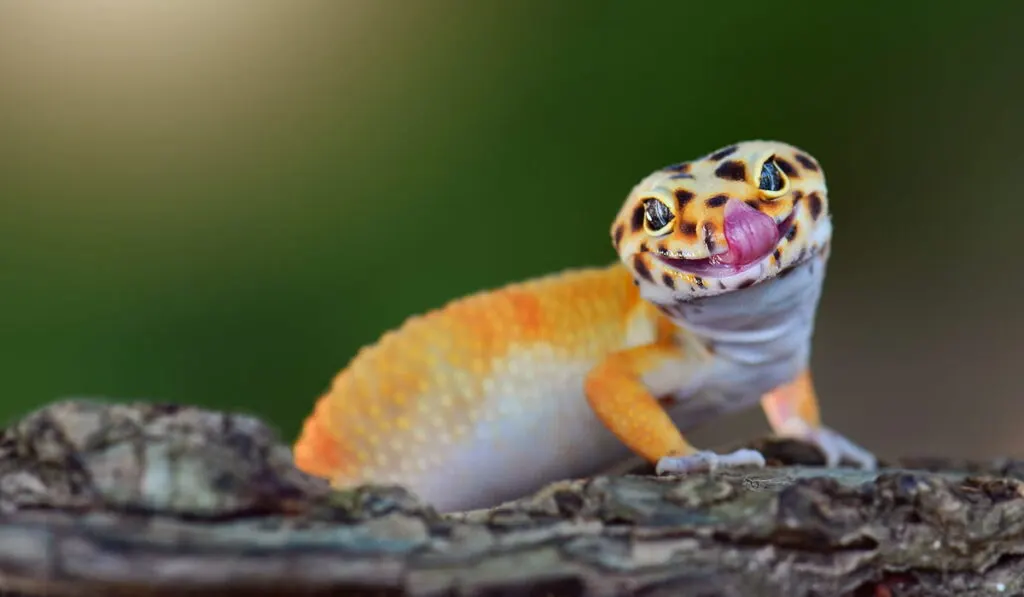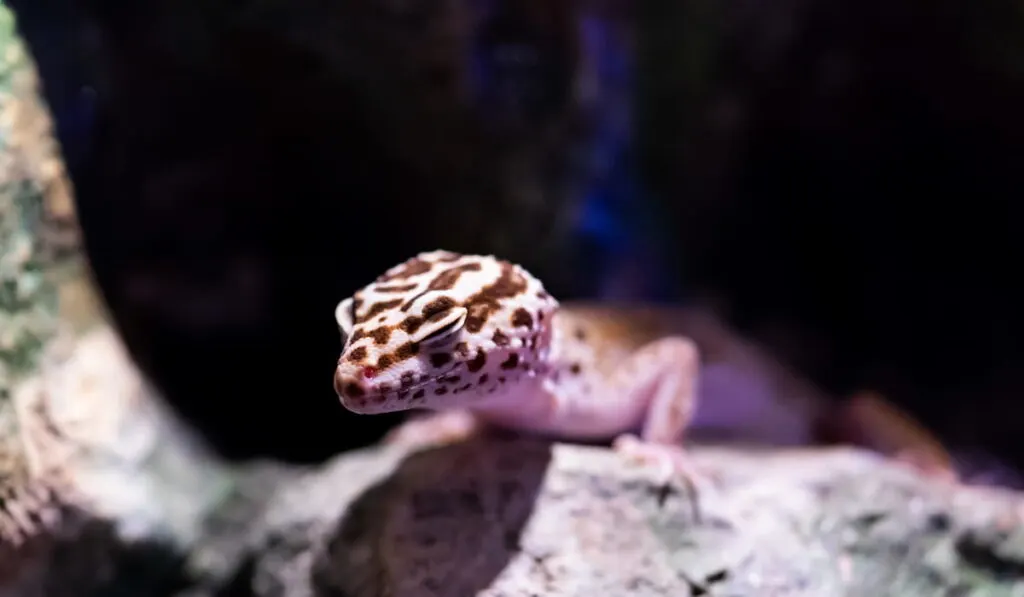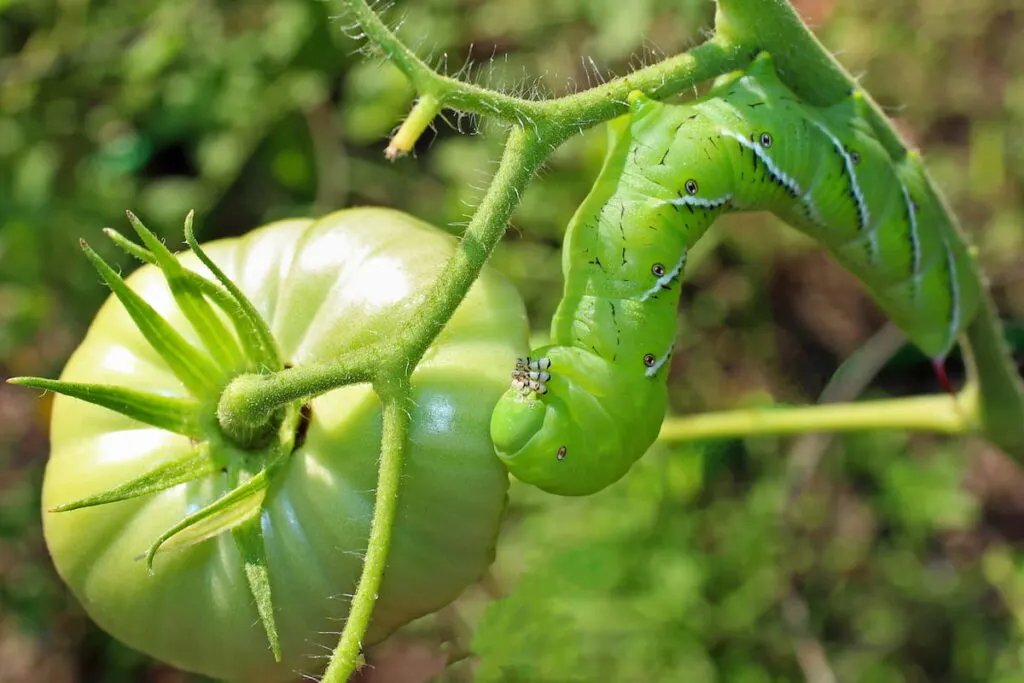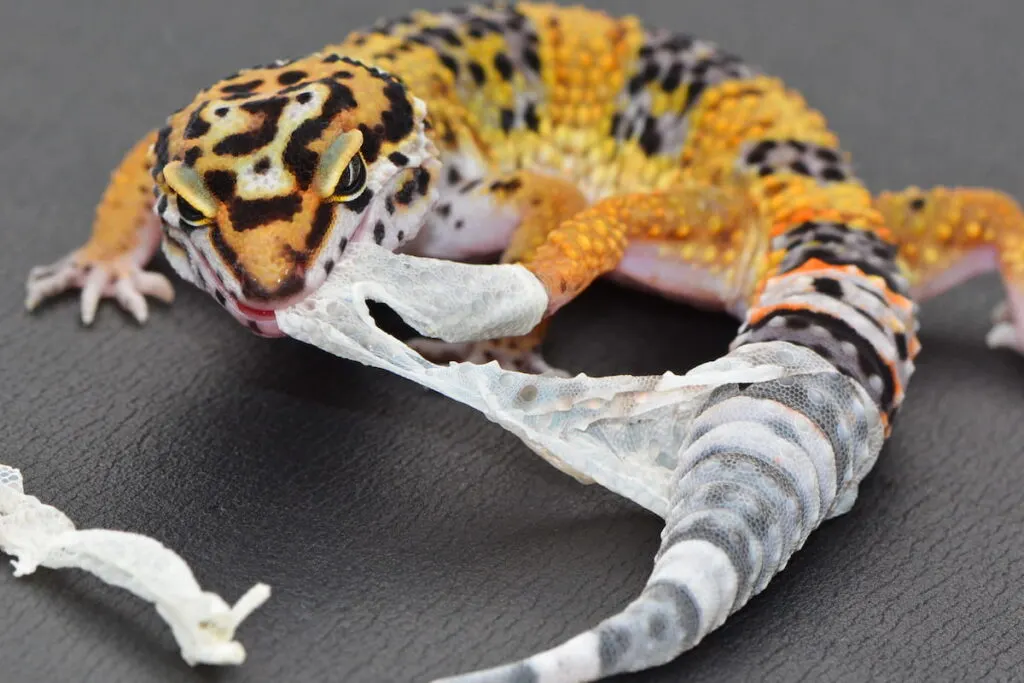Leopard geckos are small, easy-to-care-for lizards that are perfect for beginner reptile lovers. They are commonly yellow and white with black spots. Usually, hatchlings have stripes that will eventually morph into spots, so don’t be alarmed if your gecko is not spotted like a leopard.
How do you care for a leopard gecko? When caring for your leopard gecko, you will need to provide it with a warm environment that also has a cooler area. You should feed them the proper insects and avoid overfeeding them and giving them toxic insects.

The lifespan of leopard geckosis usually between 6 and 10 years in captivity but can live for up to 20 years, so give your lizard their best life by caring for them properly.
In this guide, we discuss what you need to correctly care for your leopard gecko, their preferred environments, how to feed them, and other helpful tips.
Table of Contents
What You’ll Need
The first thing you should do when purchasing a leopard gecko is to make sure you have everything you need to give it a proper comfortable home. Here is what you’ll need to care for your new friend:
1. Enclosure
Baby leopard geckos should have a 5-10 gallon tank while adults will need at least a 20-gallon tank. It is vital to give your leopard gecko the right size tank because they run the risk of developing anxiety from enclosers that are too large.
Most geckos will do fine in a larger tank, but leopard geckos are a little pickier when it comes to their tank size.
Larger tanks can make a leopard gecko feel unsafe, so if they develop anxiety from having a space that is too large, they can begin to have eating issues, which can result in weight loss.
It is also possible that they would have a harder time finding their food when the home is too big.
If you don’t have any other option and only have a larger tank, make sure you include plenty of hiding spaces for your gecko to feel safe and secure.
It is recommended that you have everything you need before deciding to purchase a leopard gecko. A tank that is too small can also cause them stress and a feeling of claustrophobia. It can also limit the amount of space they have to roam around and play.
This is an excellent video that covers tank size as well as a general overview of the things you will need.
2. Substrate
Choosing the proper substrate for your leopard gecko is crucial in making them feel comfortable and ensuring their safety. There is much debate over which substrates are best for different-aged geckos. Sand is deemed not safe for young hatchlings and even questionable for older geckos.
The problem with sand is:
- Your gecko runs the risk of ingesting it and suffering from impaction.
- They can inhale the dust and have respiratory problems.
- Wet sand can cause bacteria and mold growth.
The risks run higher with young hatchlings, so sand should be avoided. Some people do prefer to use sand for their older, healthy geckos. The benefit of using sand is that it makes scooping up waste easier and allows the gecko to bury itself in it while providing a natural look.
If you choose to use sand, opt for calcium-based fine sand because it is claimed to be digestible and safer. Provide your gecko’s food in a dish to prevent it from ingesting sand. Keep an eye on your gecko’s bowel movements to make sure sand isn’t being passed.
The best type of substrates to use for your enclosure include:
- Paper towels – Best for juvenile geckos; absorbent, hygienic, and easy to clean
- Shredded newspaper – Easy to clean and comfortable for your gecko to bury in
- Repti-carpet – Easy to clean and reduces the risk of ingestion. Watch out for loose strings
The following are substrates you should avoid because they pose the risk of injuring your leopard gecko and are not suitable for their environment:
- Wood chips
- Wood shavings
- Walnut shells
- Gravel
3. Moist Hiding Area
Leopard geckos need at least one moist hiding area (aka “hide”) in their tank for them to regulate body temperature and gain extra moisture for shedding.
The moist hide should not be placed in the gecko’s cool side of the tank because the temperature needs to be between 90-95 degrees Fahrenheit with 70-80% humidity.

If you have the moist hide in an area that is cooler, the cold will not allow it to be warm enough, which can cause the leopard gecko to get sick and develop respiratory issues.
When making a moist hide for your leopard gecko, you need a container and substrate. Suitable substrates are sphagnum moss, paper towels, or coconut fiber.
There are several ways you can make a moist hide:
- A glass box that has an entrance
- Tupperware containers
- Old plastic containers from butter or dips
- Commercial hideout made into a moist hide
When making the moist hide, make sure the container is larger than your leopard gecko and have it placed in the warm part of the tank with a heater above or below it. Depending on the type of substrate used, you want to refresh the water either once a day or every other day.
Here are the steps you should take to create a moist hide for your leopard gecko:
- Choose the container you wish to use
- Make an entrance for your lizard by cutting out a hole it can fit in
- Add substrate and spray with water
- Place in a warm part of the tank with a heater to create humidity
4. Heating Source
Leopard geckos are not able to control their body heat, so they rely on the warmth of their environment to keep them cozy. Improper heating sources can cause digestive issues and other health problems, so it is crucial to make sure you are providing the right heat for your gecko.
It is highly recommended to set up a warm side and a cool side of your leopard gecko’s tank. This will prevent your little friend from overheating and will allow them to cool down or warm up when needed. To do this, you should use two different thermometers to control the warm and cool side properly. You can even add a heating mat at the underside of the tank to help their bellies digest food.
Because leopard geckos are different during the night than they are during the day. This article about Leopard Gecko Habitat goes into more depth about why it is beneficial to have nighttime temperature sand daytime temperatures.
- Daytime temperature – Should be between 87-90 ℉ on the basking side and between 74-80 ℉ on the “cool” side. Leopard geckos need higher temperatures to allow their bodies to digest their food correctly. Although they have a cool side, the temperature shouldn’t be cold and should still be temperature controlled.
- Nighttime temperature – Geckos like to come out at night and lay on the warm rocks that have been heated by the sun while the temperatures are cooler. So, to imitate that, temperatures should be brought down to 70-75 ℉.
5. Thermometer and Hygrometer
Because leopard geckos need to be in a properly heated environment, you should have a thermometer in their tank so you can control the temperature. At least one is required, but having two thermometers is highly recommended because of the warm and cool sides.
A hygrometer measures the amount of humidity of an environment. Having this in your gecko’s tank will ensure the tank has the proper amount of humidity. Leopard geckos need a good amount of humidity, but too much of it can cause health problems like infection.
Feeding Your Leopard Gecko
As cute as they may seem, leopard geckos are predators and enjoy a variety of insects to snack on. Depending on your leopard gecko’s age and activity level, the type of insects, supplements, and feeding schedule will vary.

Geckos enjoy eating live insects; the best ones are crickets and mealworms. Waxworms and super worms can be given to them as a snack or treat because they are high in fat, and too many can cause your gecko to become overweight.
Other options for leopard gecko feedings are:
- Butterworms
- Silkworms
- Tomato hornworms
- Beetles
- Cockroaches
Butterworms should also be given as a snack because they are high in fat, contain inadequate calcium, and are known to be addicting to leopard geckos, which can prevent them from wanting any other food.
It is best to give your leopard gecko a variety of insects because sticking to just one kind will not give them balanced nutrition. You should avoid giving your gecko wild insects because you don’t know which ones may be toxic or covered in harmful chemicals.
Gut-loading is when you feed the insects an extra-nutritious diet for 24-hours before feeding them to give them extra health benefits. You can feed the insects a mix of fruits, veggies, and grains or buy a prepared mix from a pet store designed to gut load. It is also beneficial to dust the insects with a nutritious powder.
Some geckos enjoy eating fruits and vegetables, but leopard geckos can not correctly digest those and can only handle meat, like insects. These geckos do not possess a functioning Cecum, which is needed to digest the substances found in fruit and vegetables properly. Along with not having a Cecum, they also have a shorter digestive tract, unlike an herbivore with a longer one.
Insect Size for Leopard Geckos
When feeding your leopard gecko, size does matter. Feeding your gecko insects that are too large will make it hard for your pet to swallow and digest them properly. A good rule of them is not to feed them insects that are larger than the space between their eyes.
- Hatchlings – ⅜ inch insects
- Juvenile – ¼ inch insects
- Adult – Full-size insects
How Much To Feed Your Leopard Gecko
The number of insects you should feed your leopard gecko will vary by age and activity level. You should feed them the amount that they can quickly devour in a couple of minutes because if you feed them too much, the extra insects may escape, die, or cause your gecko to eat extra when not necessary.
After your gecko has slowed down eating, you should remove any extra food from their tank. Typically, you should give your leopard gecko two insects for every inch of their body length.
When To Feed Your Leopard Gecko
Something that makes leopard geckos so easy to care for is how little you need to feed them; they do not require several meals a day.
Because leopard geckos spend much their time sleeping during the day, they should be fed later in the day or the early evening. This will correspond with the natural time they would begin to hunt for food in the wild.
- Younger than one – feed every day
- Healthy adults – feed every other day
- Sick geckos – feed very day until strength is regained
Sometimes leopard geckos don’t have a big appetite. When that happens, leave a dish of worms in their tank for them to eat when they are ready.
What Not To Feed Your Leopard Gecko
Although leopard geckos love insects, some insects are toxic to them and should be avoided. Bugs that light up are the most toxic and need to be avoided entirely; these are fireflies and lightning bugs.
Some people think it’s okay to catch insects to give to their leopard gecko, but they run the risk of being contaminated with chemicals and toxic pesticides. So it is best to avoid feeding them insects you find outside.
However, if you insist on feeding your leopard gecko insects that you find, make sure you know exactly what kind of insect it is and be aware of the contamination. Some people trust insects that come from an organic garden.
Water
To keep your leopard gecko fully hydrated, you should make sure they always have clean, fresh water. The water should be changed out regularly. The water dish needs to be shallow so that your little lizard can drink from it without any troubles. It should also be shallow, so they are not at risk of falling in and drowning.
The dish should also be sturdy to avoid the water spilling out. You want to avoid making the substrate wet.
Shedding
Leopard geckos go through a natural phase of shedding or molting, where they shed a layer of their old skin. Often, when they shed this skin, they will eat it to replenish nutrients.

Sometimes they go through the process, and owners don’t know what to look out for, so they think something is wrong. It is beneficial to know what to look out for when your gecko is beginning the shedding process.
You may notice the following when your gecko is beginning the shedding process:
- Dulling color
- Peeling skin
- Loss of appetite
- Won’t have as many bowel movements
- Spending extra time in their moist hide
- Mood changes
- Constantly rubbing their skin
This shedding process can take between 48-72 hours, and you will see them rubbing up against everything to try to remove the skin. It is helpful to remove food items and water bowls, so they are not spilling it all over the place.
Other things to be aware of during the shedding process include:
- Try not to handle them too much.
- They can seem lethargic.
- The skin will change from a greyish color to a semi-white.
They will go through this process every two weeks while they are babies and pre-adults. Adults do it less frequently, once every month, sometimes every month and a half.
Stuck Shed
It can be tempting to want to peel the skin of your gecko for them, but you should avoid this as much as possible and let them shed at their own pace. Common areas where you can find shed being stuck are the toes, tip of the tail, eyes, and nostrils.
If the shed becomes stuck and is not removed, it can constrict the flow of blood to the arms and legs, which can eventually cause them to lose their toes. Skin stuck over the nose can cut off the air supply, while skin near the eyes can cause blindness.
What you can do to help your leopard gecko finish the shedding process includes:
- Check humidity levels
- Replenish the moist hide
- Spray the paper towels or substrate to provide extra moisture
- Create a sauna
- Create a humid hide
After your gecko has spent some time in their sauna or humid hide, you can help them remove the remaining skin by gently rubbing it away. You can use q-tips or tweezers to try to remove that skin.
Cleaning Your Leopard Gecko’s Home
To keep your leopard gecko happy and healthy, you need to make sure you are keeping their environment clean and comfortable. Cleaning your gecko’s tank regularly will prevent the growth of bacteria and viral infections. It will also prevent it from having a foul smell that they won’t enjoy and that you will not enjoy.
How Often Should You Clean
Properly taking care of your leopard gecko’s tank is not an overly tedious task and is reasonably easy to do. In addition to doing a deep clean from time to time, there are some small maintenance tasks you can do to keep the tank cleans.
- Clean the water dish and change the water daily
- Remove feces daily, preferably when you notice them
- Change substrate 1-2 times per week
- Clean the glass weekly
- Disinfect inside the cage once a month – remove and wash all accessories
In Conclusion
Leopard geckos are an excellent pet to have and are easy to care for. But before purchasing one, it is best to learn the importance of proper care. They’ll need the right size tank that will allow them to grow correctly and prevent any anxiety. Their tank should be at the perfect temperature and humidity to help them regulate their body temperatures and will enable them to have healthy shedding.
This is a list of some of the other websites we used as sources for this article:
